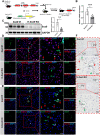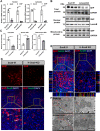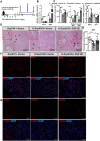Hepatocyte-specific Sox9 knockout ameliorates acute liver injury by suppressing SHP signaling and improving mitochondrial function
- PMID: 37649095
- PMCID: PMC10468867
- DOI: 10.1186/s13578-023-01104-5
Hepatocyte-specific Sox9 knockout ameliorates acute liver injury by suppressing SHP signaling and improving mitochondrial function
Abstract
Background and aims: Sex determining region Y related high-mobility group box protein 9 (Sox9) is expressed in a subset of hepatocytes, and it is important for chronic liver injury. However, the roles of Sox9+ hepatocytes in response to the acute liver injury and repair are poorly understood.
Methods: In this study, we developed the mature hepatocyte-specific Sox9 knockout mouse line and applied three acute liver injury models including PHx, CCl4 and hepatic ischemia reperfusion (IR). Huh-7 cells were subjected to treatment with hydrogen peroxide (H2O2) in order to induce cellular damage in an in vitro setting.
Results: We found the positive effect of Sox9 deletion on acute liver injury repair. Small heterodimer partner (SHP) expression was highly suppressed in hepatocyte-specific Sox9 deletion mouse liver, accompanied by less cell death and more cell proliferation. However, in mice with hepatocyte-specific Sox9 deletion and SHP overexpression, we observed an opposite phenotype. In addition, the overexpression of SOX9 in H2O2-treated Huh-7 cells resulted in an increase in cytoplasmic SHP accumulation, accompanied by a reduction of SHP in the nucleus. This led to impaired mitochondrial function and subsequent cell death. Notably, both the mitochondrial dysfunction and cell damage were reversed when SHP siRNA was employed, indicating the crucial role of SHP in mediating these effects. Furthermore, we found that Sox9, as a vital transcription factor, directly bound to SHP promoter to regulate SHP transcription.
Conclusions: Overall, our findings unravel the mechanism by which hepatocyte-specific Sox9 knockout ameliorates acute liver injury via suppressing SHP signaling and improving mitochondrial function. This study may provide a new treatment strategy for acute liver injury in future.
Keywords: Acute liver injury; Hepatocyte; Mitochondria; SHP; Sox9.
© 2023. Society of Chinese Bioscientists in America (SCBA).
Conflict of interest statement
The authors declare that they have no competing interests.
Figures







Similar articles
-
Hepatocyte SHP deficiency protects mice from acetaminophen-evoked liver injury in a JNK-signaling regulation and GADD45β-dependent manner.Arch Toxicol. 2018 Aug;92(8):2563-2572. doi: 10.1007/s00204-018-2247-3. Epub 2018 Jun 25. Arch Toxicol. 2018. PMID: 29943110
-
Small heterodimer partner overexpression partially protects against liver tumor development in farnesoid X receptor knockout mice.Toxicol Appl Pharmacol. 2013 Oct 15;272(2):299-305. doi: 10.1016/j.taap.2013.06.016. Epub 2013 Jun 26. Toxicol Appl Pharmacol. 2013. PMID: 23811326 Free PMC article.
-
SOX9 Overexpression Ameliorates Metabolic Dysfunction-associated Steatohepatitis Through Activation of the AMPK Pathway.J Clin Transl Hepatol. 2025 Mar 28;13(3):189-199. doi: 10.14218/JCTH.2024.00197. Epub 2024 Dec 20. J Clin Transl Hepatol. 2025. PMID: 40078197 Free PMC article.
-
A Novel Sox9/lncRNA H19 Axis Contributes to Hepatocyte Death and Liver Fibrosis.Toxicol Sci. 2020 Sep 1;177(1):214-225. doi: 10.1093/toxsci/kfaa097. Toxicol Sci. 2020. PMID: 32579217
-
Increase of SOX9 promotes hepatic ischemia/reperfusion (IR) injury by activating TGF-β1.Biochem Biophys Res Commun. 2018 Sep 3;503(1):215-221. doi: 10.1016/j.bbrc.2018.06.005. Epub 2018 Jun 11. Biochem Biophys Res Commun. 2018. PMID: 29879429
Cited by
-
The obeticholic acid can positively regulate the cancerous behavior of MCF7 breast cancer cell line.Mol Biol Rep. 2024 Feb 1;51(1):250. doi: 10.1007/s11033-023-09106-9. Mol Biol Rep. 2024. PMID: 38302816
-
SOX9 plays an essential role in myofibroblast driven hepatic granuloma integrity and parenchymal repair during schistosomiasis-induced liver damage.PLoS Pathog. 2025 Jun 9;21(6):e1012928. doi: 10.1371/journal.ppat.1012928. eCollection 2025 Jun. PLoS Pathog. 2025. PMID: 40489560 Free PMC article.
References
Grants and funding
LinkOut - more resources
Full Text Sources
Research Materials

